Pork and Cabbage Omelette (Tonpeiyaki) is a popular dish in the Kansai region. Plenty of shredded cabbage and thinly sliced pork are sautéed, then wrapped in an omelette. Sweet fruity tonkatsu sauce and mayonnaise are a must.
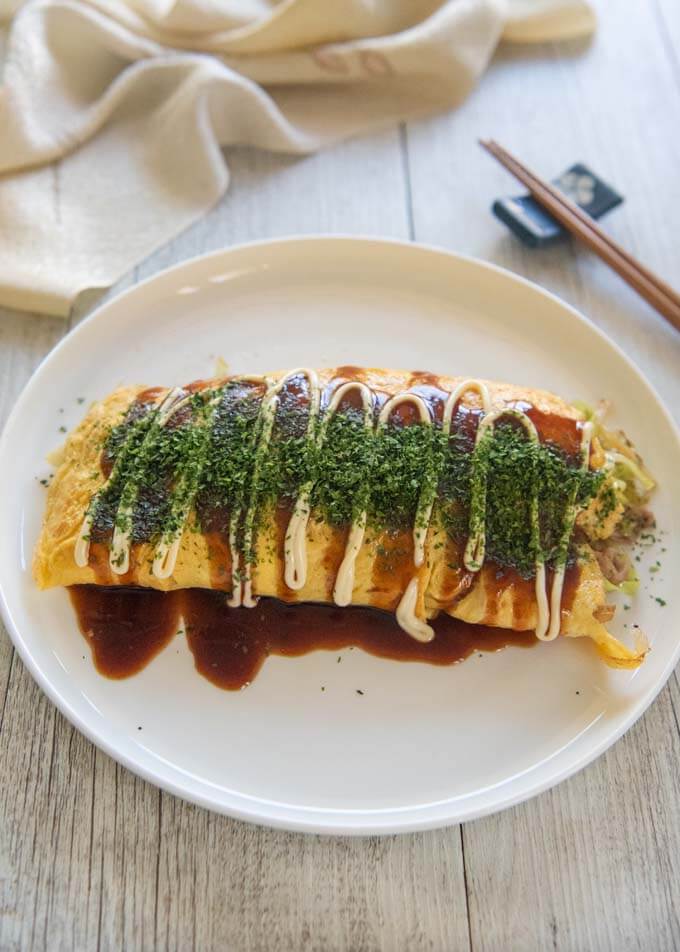
Tonpeiyaki (とん平焼き) originated in Umeda, Osaka. The owner of the restaurant called ‘hontonpei’ (本とん平) invented this dish after World War II. The owner had a Siberian internment experience and that was when he encountered the Russian pancake, blini which was the basis for the invention of Tonpeiyaki.
The original Tonpeiyaki is made with flour-based pancake, a pork slice, and an omelette, cooked like a piccata or a simplest style of Okonomiyaki. Because pork is cooked flat, it is called Tonpeiyaki.
The Kanji character for pork, 豚 is read as ‘buta’ as well as ‘ton’ (とん). The Kanji character for flat, 平 is read as ‘taira’ as well as ‘hei’ or ‘pei’. The word ‘yaki’ (焼き) means cook/grill.
Even today, the restaurant Hontonpei serves the original version of Tonpeiyaki. However, many different versions of Tonpeiyaki were introduced over time and the one that is similar to my Tonpeiyaki, i.e., pork and cabbage wrapped in an omelette without a pancake, became popular among Japanese people.
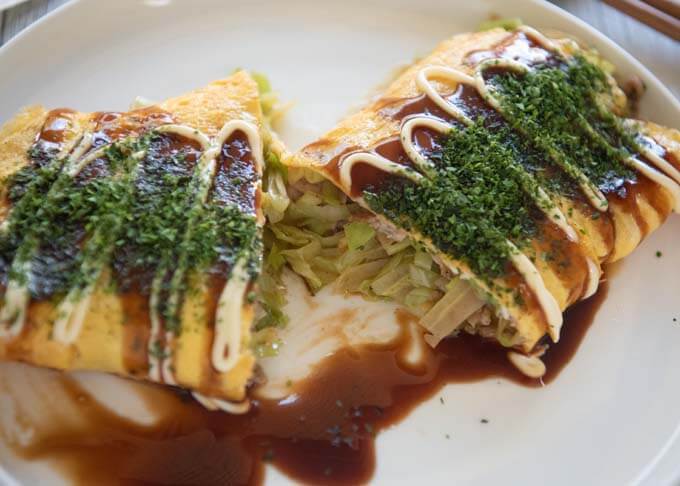
What’s in My Pork and Cabbage Omelette (Tonpeiyaki)
There are only 3 main ingredients – pork, cabbage, and egg. Other ingredients are seasonings and toppings. I grouped the ingredients into Filling, Omelette, and Toppings.
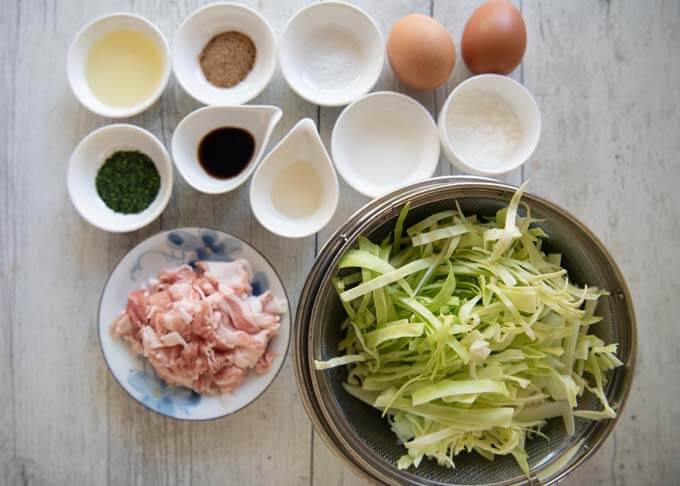
Filling
- Shredded cabbage
- Thinly sliced pork cut into bite size pieces
- Dashi powder
- Mirin
- Soy sauce
- Oil to sauté fillings
I used the most commonly used filling but there are recipes that use different ingredients for the filling. Please see the subsequent section, TONPEIYAKI FILLING VARIATIONS for filling ideas.
It is best to use about 2mm/3⁄32″ thick pork slices so that the pork becomes tender when cooked.
Omelette
- Beaten eggs
- Corn flour/cornstarch
- Sake (or water) to dilute corn flour/cornstarch
- Salt
- Oil
Starch from the corn flour works as a glue, making the omelette harder to tear.
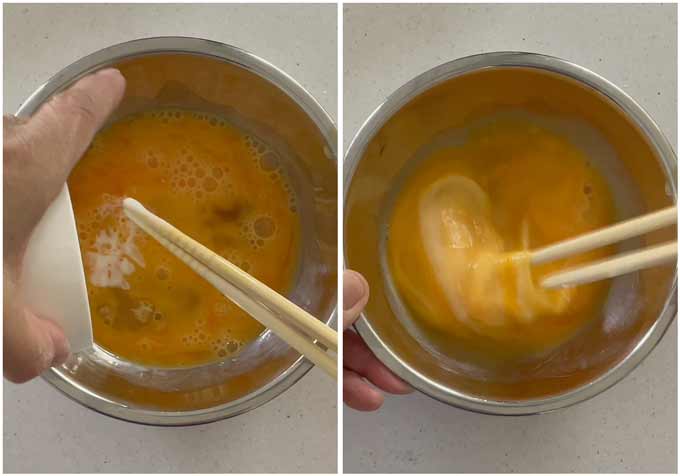
Toppings
- Tonkatsu sauce
- Mayonnaise (preferably Kewpie brand)
- Aonori
I used Bulldog brand tonkatsu sauce, but you can of course use a different brand. For Tonpeiyaki, I think a fruity thick sauce suits better. As an alternative to tonkatsu sauce, you can mix Worcestershire sauce and tomato sauce with/without sugar, which makes the sauce thick and sweet.
Instead of aonori, you can scatter finely chopped green onion. You can also add katsuobushi, if you like.
How to Make Pork and Cabbage Omelette (Tonpeiyaki)
There are two phases to make Tonpeiyaki. You cook filling first, then make an omelette to wrap the filling. See the video.
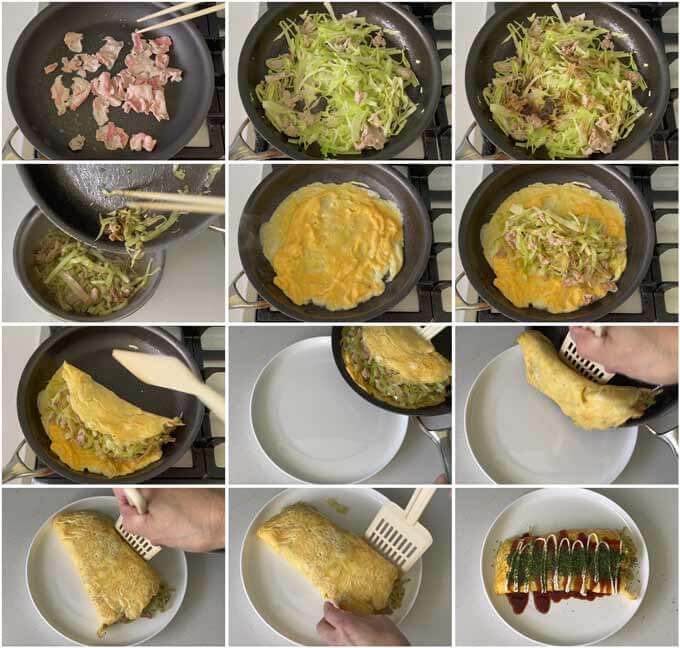
- Sauté pork slices and shredded cabbage in a frying pan, then add seasonings.
- Transfer the pork and cabbage to a bowl.
- Wipe and clean the frying pan and heat oil.
- Mix corn flour and sake well, then mix it into the egg.
- Put the egg in the pan and mix gently to make the egg fluffy.
- Place the sautéed pork and cabbage in the centre of the egg.
- Using a spatula, fold one end of the egg over the filling.
- Slide the omelette towards a serving plate, then flip the omelette over.
- Drizzle tonkatsu sauce and mayonnaise over the omelette drawing a narrow zig-zag pattern, then sprinkle aonori.
Transferring the half-covered omelette onto a serving plate might look a bit difficult, but you will be surprised to learn that it can flip easily without breaking the omelette (thanks to the corn flour). If you tilt your frying pan and shift the omelette to the edge of the pan, it will become easier to flip.
If some pork and cabbage pieces scattered around the omelette, push them under the omelette.
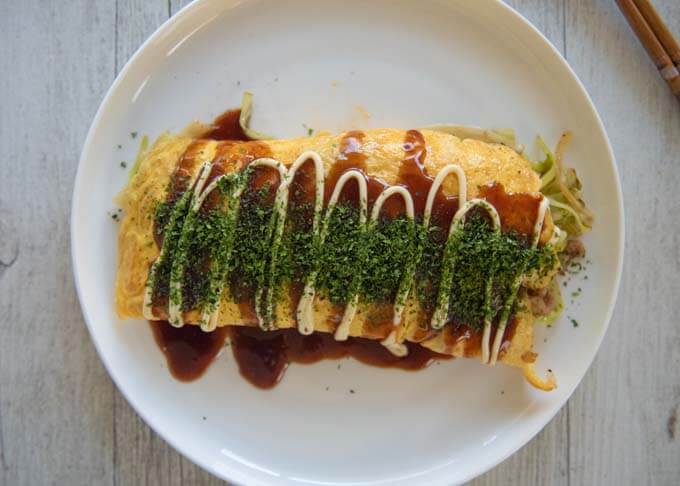
Tonpeiyaki Filling Variations
Because the dish is Tonpeiyaki, the fillings should include pork in theory. But you can of course make vegetarian fillings if you prefer. The following ingredient combinations are to be sautéed with sliced pork, except the last one.
- Cabbage, bean sprouts
- Cabbage and spinach
- Cabbage and rice
- Cabbage and Kimchi
- Cabbage and Benishōga and/or tenkasu
- Avocado & cheese
- Cabbage, canned tuna (instead of pork), and corn fillings inst
The photo below is a Tonpeiyaki with cabbage and kimchi. It was delicious.
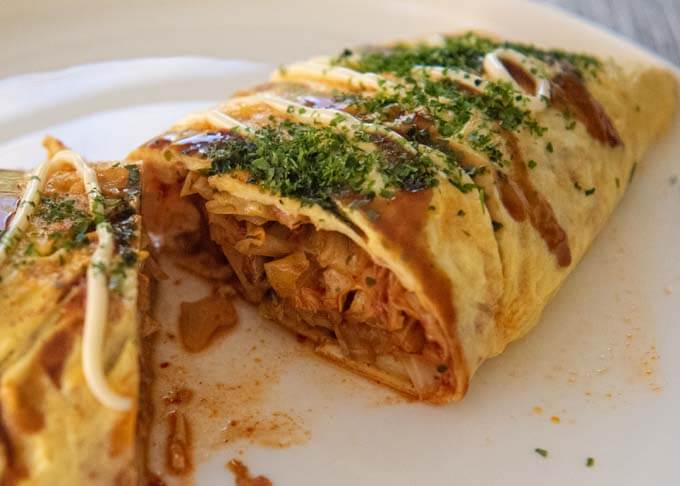
Pork and Cabbage Omelette (Tonpeiyaki) is surprisingly light, perhaps due to the small amount of pork against the shredded cabbage. The recipe calls for 2 servings, but I know you can eat a whole by yourself. I have done that. I was hungry and it was so tasty that I could not stop eating it!
Yumiko![]()
Watch How To Make It
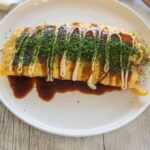
Pork and Cabbage Omelette (Tonpeiyaki) is a dish popular in the Kansai region. Plenty of shredded cabbage and thinly sliced pork are sautéed, then wrapped in an omelette. Sweet fruity tonkatsu sauce and mayonnaise are a must. Watch the video.
Don't forget to see the section 'MEAL IDEAS' below the recipe card! It gives you a list of dishes that I have already posted and this recipe that can make up a complete meal. I hope it is of help to you.
- 200g/7.1oz cabbage cut to 5mm/3⁄16" wide strips
- 80g/2.8oz sliced pork thinly sliced and cut into bite size pieces (note 1)
- 1 tsp dashi powder (note 2)
- 1 tsp mirin
- 1 tsp soy sauce
- 1 tsp oil (note 3)
- 2 eggs beaten
- 1 tbsp corn flour/cornstarch
- 1 tbsp sake (or water)
- A pinch of salt
- 2 tsp oil
- Tonkatsu sauce (note 4)
- Mayonnaise (Kewpie brand suits best)
- Aonori (or finely chopped green onion)
-
Heat oil in a frying pan (note 5) over medium heat. Add pork and sauté for a minute or so until the colour of the pork changes to whitish.
-
Add cabbage to the pan and sauté until the cabbage pieces become wilted. About 3-5 minutes.
-
Add the rest of the Filling ingredients and mix well, then transfer the filling to a bowl.
-
Put corn flour/cornstarch, sake, and a pinch of salt in a small container and mix well ensuring that the mixture is runny with no dense corn flour/cornstarch at the bottom (note 6).
-
Add the diluted corn flour/cornstarch to the beaten egg and mix well (note 6).
-
Wipe the frying pan with a kitchen paper, and heat oil over medium low heat.
-
Pour the egg into the frying pan. As the bottom of the egg starts cooking, mix the egg slightly to make the omelette fluffy.
-
While the surface of the egg is still slightly wet, place the filling in the middle of the egg, spreading one direction so that you will have a band of the filling on the egg. You should have about the similar width of the egg-only portion on both sides of the filling.
-
Using a spatula, lift one side of the egg-only portion and gently cover the filling. The omelette becomes a shape of wide half circle.
-
Turn the heat off and rotate the omelette so that the straight line of the omelette is aligned to the handle of your frying pan and the round side of the omelette is on the left side of the handle (for the right handers).
-
Place the frying pan on the edge of a serving place, tilting slightly so that the omelette can easily slide onto the plate.
-
Place the spatula underneath the omelette from the straight side, then in one motion flip it over onto the plate. Both sides of the omelette should be tucked in (note 7).
-
Drizzle tonkatsu sauce over the omelette drawing a narrow zig-zag pattern. Do the same with mayonnaise, then sprinkle aonori over.
-
Serve to share or cut into half and serve individually while hot.
1. I used thinly sliced (about 2mm/3⁄32" thick) pork belly strips cut into 4-5cm/1½-2" long pieces. It is best to use very thin slices.
You can use other cuts of pork slices if you want to cut down calories.
2. I used the powdered katsuobushi in a sachet. Dashi sachet is usually boiled to get dashi stock out of it, but I cut the sachet open and used the powder in it.
If you are using granular bonito-flavoured seasoning instead, you will only need ½ teaspoon of it.
3. I only used a small amount of oil to cook fillings because the pork belly came with quite a bit of fat. If you are using lean pork, you may want to double the quantity of oil.
4. I used the Bulldog brand tonkatsu sauce. You can find more details about Bulldog sauces in my post Yakisoba.
If you only have Worcestershire sauce, you can mix 1 part Worcestershire sauce with 1 part ketchup and a small amount of sugar.
5. I used 26cm/10" frying pan, which is about the right size to make a Tonpeiyaki for 2 servings. If your frying pan is too small, the filling will be too much for the size of your omelette. If the pan is too large, your omelette will be too thin.
If you are making 4 servings, you have an option of making two omelettes as per the recipe instructions or use a larger frying pan and make a big Tonpeiyaki.
6. This can be done before cooking fillings.
7. If the omelette was not tidy, that's OK. You can use a hand and the spatula to tuck the sides of the omelette in. If the fillings that are scattered outside of the omelette, push them underneath the omelette.
8. Nutrition per serving. I used pork belly which increased the calories and the fat figures. If you use lean pork, you can significantly reduce these.
serving: 213g calories: 393kcal fat: 33g (51%) saturated fat: 9.8g (49%) trans fat: 0.1g polyunsaturated fat: 4.5g monounsaturated fat: 17g cholesterol: 215mg (72%) sodium: 318mg (13%) potassium: 341mg (10%) carbohydrates: 10g (3%) dietary fibre: 2.8g (11%) sugar: 4.5g protein: 12g vitamin a: 7.6% vitamin c: 61% calcium: 5.5% iron: 9.4%
Meal Ideas
A typical Japanese meal consists of a main dish, a couple of side dishes, a soup and rice. I try to come up with a combination of dishes with a variety of flavours, colours, textures and make-ahead dishes.
Tonpeiyaki is quite sweet because of the tonkatsu sauce. So, I wanted a couple of side dishes that do not contain sugar and compliment the main dish. I also wanted a small amount of protein in the side dish.
A combination of Stir-fried Choy Sum with Deep-fried Tofu and Tataki Kyūri meets the requirements. A clear soup cleanses your palate.
- Main: Pork and Cabbage Omelette (Tonpeiyaki) – today’s recipe.
- Side dish 1: Stir-fried Choy Sum with Deep Fried Thick Tofu – or other tofu dish.
- Side dish 2: Tataki Kyuri (Smashed Cucumber Salad) – or Cucumbers Pickled in Shio Kōji.
- Soup: Clear Soup with Clam – or other clear soup.
- Rice: Cooked Rice.
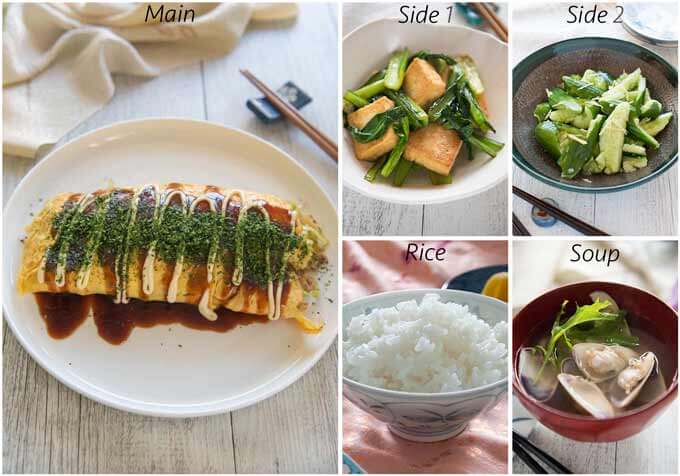
Soooo yummy Thankyou I made this tonight as a quick meal for my Japanese student and I. My students thought she was back in Japan she loved it!!! Such a good quick authentic recipe with lip smacking umami. Definitely making this again!
That’s fantastic, Libby! You must be very proud to impress your Japanese student, and so you should!
This sounds so-o-o good. When I get back to cooking, I am definitely going to try it. The only thing I plan to do differently is to cook it like a frittata, pour the eggs over the filling ingredients once they’re ready – sort of a giant egg foo yong, but Japanese. I may add bean sprouts too, as that sounds really good! I’ll let you know how it turns out.
Hi Lynne, that sounds delicious. Bean sprouts go well with it too. I look forward hearing from you!
I am from Spain and I have just discovered your blog. It’s amazing!!! I love Japanese food, but here there are no many places where I can find it. Thank you so much for your work!!!!
Hi Olga, welcome to RecipeTin Japan! I hope you cooke many dishes from my site. Please let me know what you think of the dishes you made.
5⭐️’ s just because of the pre story about how the dish came about and 5 ⭐️’s because it sounds and looks so good. I always love your all your info and especially all the extra recipes of which I have made quite a few of them.
Thankyou
Hi Lindi, thank you very much for the doubler 5 stars! Please make it and let me know what you think.